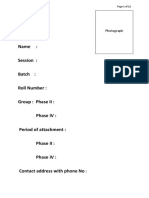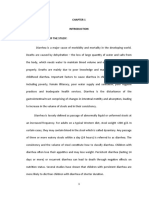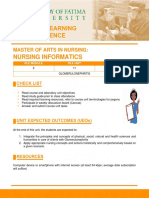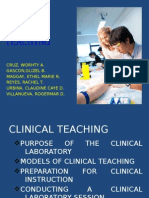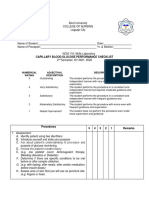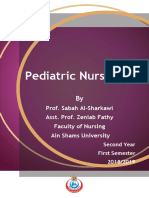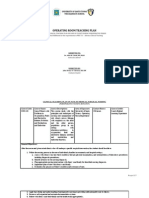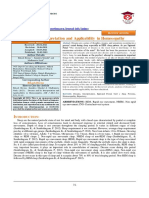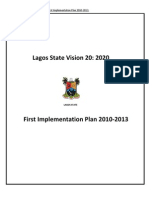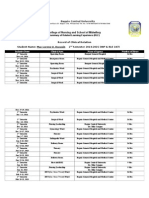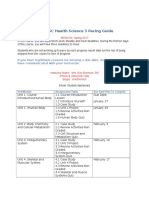Professional Documents
Culture Documents
GIS Modul 3 History Taking & Physical Examination of Diarrhea%
Uploaded by
Windu KumaraCopyright
Available Formats
Share this document
Did you find this document useful?
Is this content inappropriate?
Report this DocumentCopyright:
Available Formats
GIS Modul 3 History Taking & Physical Examination of Diarrhea%
Uploaded by
Windu KumaraCopyright:
Available Formats
History Taking & Physical
Examination of Diarrhea and
Dehydration
1. General Objective
After finishing skill practice of clinical examination of diarrhea, the student will be
able to perform history taking and physical examination of diarrhea, to determine
the severity and the management of diarrhea correctly.
2. Specific Objective :
At the end of skill practices, the student will be able to perform clinical
examination and management of diarrhea correctly.
3. Syllabus Description :
a. Sub Module Objective
After finishing skill practice of examination of acute abdomen, the
student will be able to perform history taking and physical examination
of acute abdomen correctly.
b. Expected Competencies
▪ Students perform history taking of diarrhea.
▪ Students perform physical examination of diarrhea.
▪ Students perform management of diarrhea based on the severity.
c. Topics
▪ History taking of diarrhea
• Greet the patient and parents and confirm identity: train the student
to perform the informed concent, and collecting the patient data.
• Chieft complain: Determine the chief complaint and onset of illness,
train the student to collect data of chief complaint and timeline of
the symptom.
• Other related symptoms: train the student to get other information
related of the symptoms of diarrhea.
• Collect the previous history, family history, other significant illness,
and house environment: train the student to find the risk factor of the
present illness.
• Collect the history of current medication: to collect data about
present medication.
▪ Physical examination of diarrhea.
• Preparation: train the students to perform informed consent and
prepare the patient and also them selve for the physical examination.
• Implementation
o General examination: train the students to examine general
appearance and the signs of dehydration.
o Decision: train the students to make decision the severity of
dehydration.
o Management: train the students to manage the diarrhea based on
the severity of dehydration.
Clinical Skill Manual GIS | 9
d. Methods
▪ Presentation
▪ Demonstration
▪ Coaching
▪ Self practices: role - play
A. Attachment
1. Instrument, substances and material needed
Presentation :
Audiovisual : Slides presentations on LCD projector.
Demonstration and coaching :
a. Table
b. Chairs
c. Examination couch
d. Baby manequin
e. Oral rehydration solution
2. Assessment:
Performance scale 0 = Neither mention nor do the procedure
Performance scale 1 = Only mention the procedure
Performance scale 2 = Mention and do the procedure
3. Speciment Handling
4. Standardized patient& Preparation for the Patient
This skills not need standardized patient.
5. Venue
Skills Laboratory, C5 building fl.1, Faculty of Medicine Universitas Padjadjaran
6. Reference
7. Resource Department: Pediatric Department, Faculty of Medicine Universitas
Padjadjaran
Clinical Skill Manual GIS | 10
Learning Guide HTPE Diarrhea
Performance
No. Steps Scales
0 1 2
HISTORY TAKING
1 Greet the mother.
2 Introduce yourself.
3 Ask the patient’s name and age.
4 Ask about the reason why she comes to you.
5 Ask about the onset/duration of diarrhea.
6 Ask about the frequency and amount of diarrhea.
7 Ask about the nature of diarrhea: bloody, mucous or watery stool.
8 Ask about the progression of the complaint.
Ask related symptoms (9-11)
9 Nausea and vomiting
10 Fever and cough
11 Micturition
12 Previous history of feeding (breast milk or formula milk feeding)
Ask about signs of dehydration: irritability, restlessness,lethargy, eager to
13
drink
Tell the mother’s patient about the conclusion of the patient’s history
14.
taking.
PHYSICAL EXAMINATION
1 Greet the mother.
2 Introduce yourself.
3 Wash & dry hand
4 Ask permission from the mother
Examine the child’s general appearance (lethargy or unconscious or
5
floppy)
6 Examine the eyes (very sunken)
7 Observe tears (Absent)
8 Examine the mouth and tongue (Very dry)
9 Observe patient when drink (Drinks poorly)
10 Perform skin pinch (Goes back very slowly)
Clinical Skill Manual GIS | 11
You might also like
- Medical Microbiology for the New Curriculum: A Case-Based ApproachFrom EverandMedical Microbiology for the New Curriculum: A Case-Based ApproachNo ratings yet
- Ceklis OSCE Semester 5Document44 pagesCeklis OSCE Semester 5Denden AllatifNo ratings yet
- CSL 6 - HT PE Groin LumpDocument5 pagesCSL 6 - HT PE Groin LumpSalsabilla Ameranti PutriNo ratings yet
- Skills 5 - HT Pe AbdomenDocument5 pagesSkills 5 - HT Pe AbdomenSalsabilla Ameranti PutriNo ratings yet
- Final Clinical Card ContentDocument21 pagesFinal Clinical Card ContentMahir FaysalNo ratings yet
- Eye Irrigation ChecklistDocument3 pagesEye Irrigation ChecklistAlma Janella TOSINONo ratings yet
- First P. B. B. Sc. Nursing Revised Syllabus 2005 Proforma & Guidelines For Internal Assessment & EvaluationDocument32 pagesFirst P. B. B. Sc. Nursing Revised Syllabus 2005 Proforma & Guidelines For Internal Assessment & Evaluationvasini71100% (2)
- Abdominal Assessment: Case Stud yDocument20 pagesAbdominal Assessment: Case Stud ySheri AnjumNo ratings yet
- Diarrhea New Edited 2Document82 pagesDiarrhea New Edited 2bharathNo ratings yet
- Ugib Case PresDocument38 pagesUgib Case PresKyla R. PinedaNo ratings yet
- Clinical Objectives GuidelinesDocument11 pagesClinical Objectives GuidelinesprowritttersNo ratings yet
- History Taking ChecklistDocument3 pagesHistory Taking ChecklistPatrick SantosNo ratings yet
- Ear Irrigation ChecklistDocument3 pagesEar Irrigation ChecklistAlma Janella TOSINO100% (1)
- Pediatric Syll Clincal Practical. 2022-2023Document49 pagesPediatric Syll Clincal Practical. 2022-2023Shumukh MohammedNo ratings yet
- Nephrology unit residency curruculum and management protocols - 2nd editionDocument34 pagesNephrology unit residency curruculum and management protocols - 2nd editiondockhady870No ratings yet
- Master of Arts in Nursing: GlomerulonephritisDocument3 pagesMaster of Arts in Nursing: GlomerulonephritisMaica LectanaNo ratings yet
- BSN12C Group 12 - ManuscriptDocument73 pagesBSN12C Group 12 - ManuscriptMICHELLE FACTONo ratings yet
- Diarrhea Treatment ProgramDocument10 pagesDiarrhea Treatment ProgramAnisa Putri AndiniNo ratings yet
- Group 33 Module 7 ManuscriptDocument56 pagesGroup 33 Module 7 ManuscriptMARIA KHIM ROSE BALCITANo ratings yet
- ClinicalDocument16 pagesClinicalEthel Marie Maggay MangadaNo ratings yet
- Urine Collection: - Clinical Instructor (Sign Over Printed Name)Document2 pagesUrine Collection: - Clinical Instructor (Sign Over Printed Name)hey aadarshaNo ratings yet
- Care of Mother, Child, Adolescent: GoalsDocument8 pagesCare of Mother, Child, Adolescent: GoalschelseyNo ratings yet
- Acute Gastroenteritis With Moderate Dehydration, Congenital IchthyosisDocument36 pagesAcute Gastroenteritis With Moderate Dehydration, Congenital IchthyosisSunshine JaranillaNo ratings yet
- MS Rle Go, So, Dpa, Assessment (07-29-21)Document8 pagesMS Rle Go, So, Dpa, Assessment (07-29-21)Rhea Mala-Ay TorregosaNo ratings yet
- tiến trình bài giảng Unit 6 fighting choleraDocument23 pagestiến trình bài giảng Unit 6 fighting cholerayennhi228anneNo ratings yet
- Management of Acute Diarrhoea in Children by Dr. HiraDocument25 pagesManagement of Acute Diarrhoea in Children by Dr. Hirasaadkhalid8No ratings yet
- Child Health Nursing NURS 362Document12 pagesChild Health Nursing NURS 362Fatimah FaqihiNo ratings yet
- Diabetic KetoacidosisDocument21 pagesDiabetic KetoacidosisDrishti ShresthaNo ratings yet
- History ChecklistDocument5 pagesHistory ChecklistDianeNo ratings yet
- Name: - Date Performed: - Year & SectionDocument1 pageName: - Date Performed: - Year & SectionFrancis GongNo ratings yet
- Bedside Evaluation of DysphagiaDocument41 pagesBedside Evaluation of Dysphagiaaleeza nomanNo ratings yet
- A. Background of The StudyDocument43 pagesA. Background of The StudyJohn Robert CruzNo ratings yet
- Student Manual For Tropis 2011 EDocument52 pagesStudent Manual For Tropis 2011 ERaissa Alfaathir HeriNo ratings yet
- Skill HT PE Jaundice TA 2022-2023Document6 pagesSkill HT PE Jaundice TA 2022-2023Alfiyya nur marhdiyyahNo ratings yet
- NUR 420 Practicum Final Practicum Progress DocumentDocument7 pagesNUR 420 Practicum Final Practicum Progress DocumentBrooke GagnonNo ratings yet
- Caring for a Patient with Acute PancreatitisDocument68 pagesCaring for a Patient with Acute PancreatitisDexter Niel Ortilano CPAC-SNNo ratings yet
- Fundamental Nursing Skills GuideDocument31 pagesFundamental Nursing Skills GuideJosepheen RajaNo ratings yet
- Funda QuizDocument7 pagesFunda Quizgunn twothingNo ratings yet
- Pineda - Case Study MCN 109Document38 pagesPineda - Case Study MCN 109Kyla R. PinedaNo ratings yet
- Health Care For PublishDocument99 pagesHealth Care For PublishAlloiBialbaNo ratings yet
- Final G CaseDocument34 pagesFinal G CaseMarielle SorianoNo ratings yet
- DCH Syllabus LatestDocument19 pagesDCH Syllabus Latestk16emranNo ratings yet
- Final Portfolio by ELISABETHDocument67 pagesFinal Portfolio by ELISABETHjean uwakijijweNo ratings yet
- Clinical Focus CP 101Document3 pagesClinical Focus CP 101Fely B. Balgoa100% (2)
- Universidad de Manila: (Formerly City College of Manila) Mehan Garden, ManilaDocument24 pagesUniversidad de Manila: (Formerly City College of Manila) Mehan Garden, ManilaCeelin RoblesNo ratings yet
- Ve Efn2 TB U07Document11 pagesVe Efn2 TB U07Milka Rocha FloresNo ratings yet
- Unit of Educational Health EventDocument4 pagesUnit of Educational Health EventNita RosianiNo ratings yet
- Capillary Blood Glucose Performance Checklist: Numerical Rating Adjectival Description DescriptionDocument2 pagesCapillary Blood Glucose Performance Checklist: Numerical Rating Adjectival Description DescriptionAngeline NavarroNo ratings yet
- Share SKILLS CHECKLIST Revised1Document25 pagesShare SKILLS CHECKLIST Revised1maria laiza chicanoNo ratings yet
- Pediatric Nursing Course Prepares Nurses for Children's CareDocument109 pagesPediatric Nursing Course Prepares Nurses for Children's CareSherein ShalabyNo ratings yet
- Dengue Hemorrhagic FeverDocument54 pagesDengue Hemorrhagic FeverfortuneayaNo ratings yet
- Project Based Learning Nursing Management in Cardiovascular SystemDocument9 pagesProject Based Learning Nursing Management in Cardiovascular SystemMuhamad Ibnu HasanNo ratings yet
- CASESTUDY PyelonephritisDocument37 pagesCASESTUDY Pyelonephritisyasira100% (1)
- Nur 318 Ob Clinical AssignmentDocument49 pagesNur 318 Ob Clinical AssignmentGina FasoloNo ratings yet
- SPUTUM SPECIMEN COLLECTION Course Unit - Micro-Para LabDocument3 pagesSPUTUM SPECIMEN COLLECTION Course Unit - Micro-Para LabDan Emerson GuillermoNo ratings yet
- Assessment of The Abdomen ChecklistDocument4 pagesAssessment of The Abdomen ChecklistKyle Randolf CuevasNo ratings yet
- OPERATING ROOM TEACHING PLANDocument7 pagesOPERATING ROOM TEACHING PLANjohnhenryv100% (2)
- AMOEBIASISDocument44 pagesAMOEBIASISJorge RabajaNo ratings yet
- College of Nursing Allied Health SciencesDocument38 pagesCollege of Nursing Allied Health SciencesLemuel GuevarraNo ratings yet
- Biomolecules 11 00090 v2Document4 pagesBiomolecules 11 00090 v2Windu KumaraNo ratings yet
- J Amjmed 2017 10 035Document11 pagesJ Amjmed 2017 10 035Windu KumaraNo ratings yet
- 1 s2.0 S2414644720300208 MainDocument4 pages1 s2.0 S2414644720300208 MainWindu KumaraNo ratings yet
- Kunci Lab Activity Anatomi Blok Gis-17 Maret 2022Document2 pagesKunci Lab Activity Anatomi Blok Gis-17 Maret 2022Windu KumaraNo ratings yet
- Safety of Topical Ibuprofen GelDocument1 pageSafety of Topical Ibuprofen GelNarongchai PongpanNo ratings yet
- SBi Guidelines 233 - Protection Against Radon in New BuildingsDocument49 pagesSBi Guidelines 233 - Protection Against Radon in New BuildingsDaniela HanekováNo ratings yet
- AMDM Unit 3-Study Types (DHS 2020-2021)Document3 pagesAMDM Unit 3-Study Types (DHS 2020-2021)Stanice LouisNo ratings yet
- IntjentpDocument10 pagesIntjentpChicagoNo ratings yet
- ECG Signal Final Project-1Document9 pagesECG Signal Final Project-1Sejal NagbhidkarNo ratings yet
- Office Memorandum No. 09 SDO CSFP TASK FORCE COVID 19Document4 pagesOffice Memorandum No. 09 SDO CSFP TASK FORCE COVID 19Dally AudiaNo ratings yet
- Project Proposal PDFDocument11 pagesProject Proposal PDFkaren perrerasNo ratings yet
- .Document544 pages.Bestiana SaraLiontina0% (1)
- Aseptic Dispensing: Bilal Hassan M.Phil PharmaceuticsDocument25 pagesAseptic Dispensing: Bilal Hassan M.Phil PharmaceuticsShafaqat Ghani Shafaqat GhaniNo ratings yet
- Tayabas Western Academy: Date SubmittedDocument14 pagesTayabas Western Academy: Date SubmittedJohn Paul Madrid Arevalo100% (1)
- End - Life of Care PPT 1 MainDocument48 pagesEnd - Life of Care PPT 1 MainNancy Singh60% (15)
- National Institute Of Technology Karnataka, Surathkal Noise, and Light PollutionDocument28 pagesNational Institute Of Technology Karnataka, Surathkal Noise, and Light PollutionAnonymous GGtvR65MR100% (1)
- Dreams and Its Interpretation and Applicability in HomoeopathyDocument11 pagesDreams and Its Interpretation and Applicability in HomoeopathyDr. Bikash BiswasNo ratings yet
- Research Fellowship: Swiss Government Excellence ScholarshipsDocument4 pagesResearch Fellowship: Swiss Government Excellence ScholarshipsBrice Nestares TanohNo ratings yet
- Sample LTR - Extreme HardshipDocument3 pagesSample LTR - Extreme HardshipCarlosNo ratings yet
- SFDA Guidance For Drafting Risk Management Plans of COVID-19 VaccinesDocument16 pagesSFDA Guidance For Drafting Risk Management Plans of COVID-19 VaccinesadasdasNo ratings yet
- Lagos State Vision 20: 2020 First Implementation Plan 2010-2013 SummaryDocument75 pagesLagos State Vision 20: 2020 First Implementation Plan 2010-2013 SummaryJung Hyun Yun67% (3)
- GNLD's G1 Laundry Powder - Fast FactsDocument2 pagesGNLD's G1 Laundry Powder - Fast FactsNishit KotakNo ratings yet
- Word form siêu khó làm chao đảo thế giới ảo (nguồn tổng hợpDocument9 pagesWord form siêu khó làm chao đảo thế giới ảo (nguồn tổng hợpVu Ngoc Quynh AnhNo ratings yet
- Three Approaches To Psychotherapy GloriaDocument41 pagesThree Approaches To Psychotherapy GloriaLuisa Hernandezy67% (3)
- BMCH Family Planning Policy Provides Universal AccessDocument2 pagesBMCH Family Planning Policy Provides Universal AccessShang Dimol100% (1)
- College of Nursing and School of Midwifery: Baguio Central UniversityDocument4 pagesCollege of Nursing and School of Midwifery: Baguio Central UniversityKarlNo ratings yet
- Pregnancy Complications and Labor ManagementDocument22 pagesPregnancy Complications and Labor ManagementDon Oliveros ÜNo ratings yet
- Drug Therapy of MalariaDocument41 pagesDrug Therapy of MalariaAbby LiewNo ratings yet
- Sterilization Consent Form: LDSS-3134Document1 pageSterilization Consent Form: LDSS-3134Jack TedescoNo ratings yet
- Sss Gsis LawDocument57 pagesSss Gsis LawBroy D Brium100% (1)
- Food Hygiene AssignmentDocument13 pagesFood Hygiene AssignmentSamjhana Neupane100% (1)
- Job Safety Analysis (Hydro Jetting)Document4 pagesJob Safety Analysis (Hydro Jetting)rashid zaman57% (7)
- Pacing Guide hs3 Spring2017Document3 pagesPacing Guide hs3 Spring2017api-319728952No ratings yet
- NCP - Decreased Intracranial Adaptive Capacity R/T Space - Occupying Lesion.Document1 pageNCP - Decreased Intracranial Adaptive Capacity R/T Space - Occupying Lesion.Carl Elexer Cuyugan Ano100% (6)





